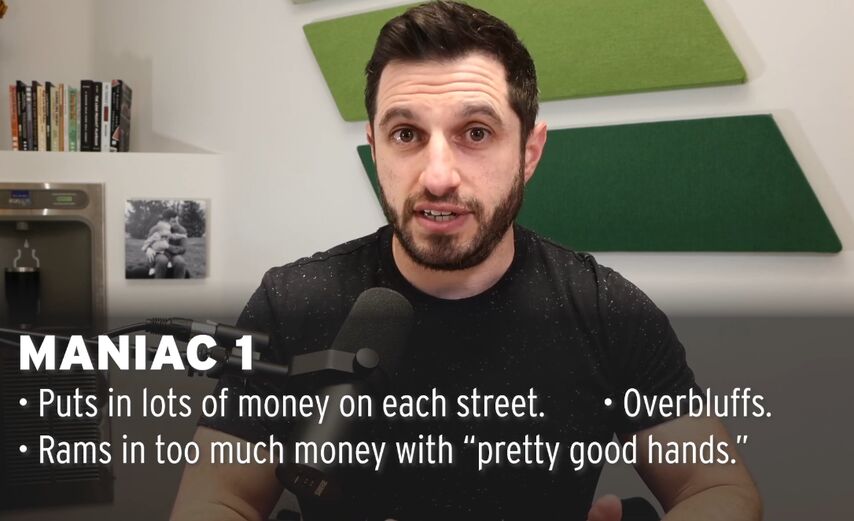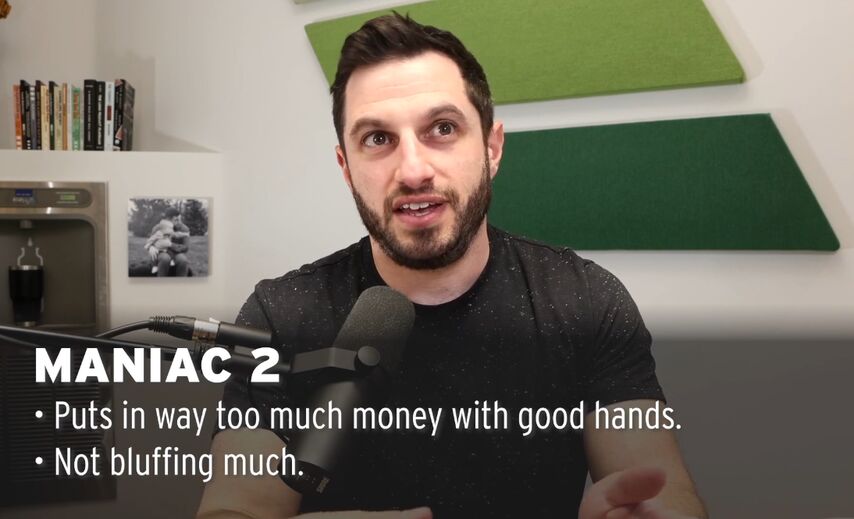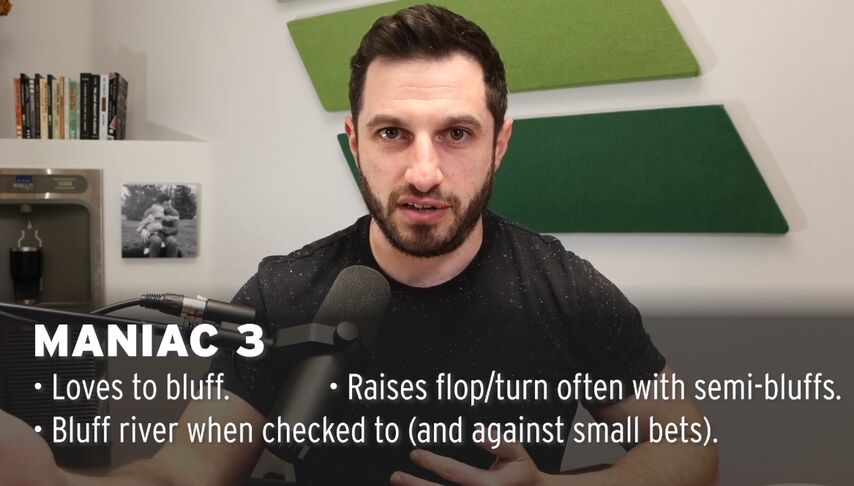Hello, this is Phil.
Everyone wants to know how to adjust when playing against maniacs. The answer depends on what kind of maniac you are facing, because they are quite different from each other. It only takes a few hands to notice a person who is happy to build the pot, but this alone is not enough to develop a good counter-strategy. Today I will tell you about three types of maniacs, each of which needs to be approached differently.
Maniac #1
He likes to bet big on every street. He bluffs too much and bets too big with good hands. Doesn't like to fold, and does it less often than he should, but isn't completely dumb and won't check-call the flop with no pairs or draws. When he has equity or feels weakness, he rushes in with huge bets and raises.

When playing with such opponents, it is important to understand that after he checks, any bet you make can run into a check-raise. Which tweak comes to mind the fastest? Play with a more polarized range. The polarized range loves to get raised. Range with thin value – no.
So we bet the flop with sets and two pair, and with flushes or straights, if there are any on the flop, and also add some bluffs. Villain will not overfold, but we need some bluffs, because he is not a complete idiot and will adjust if he sees that after any bet we have a set. And if it does, then they are welcome to check-shove 200bb with marginal hands into our nuts.
Let's say we checked next, the dealer shows the turn. If the opponent checks, we play the same way as on the flop. We can check quite strong hands a second time, which are usually not checked twice. This way we control the size of the pot and don't get into trouble after check-raising six pots. And you can get it on the river. We also check back with strong draws to realize our equity without the risk of folding it to a raise.
There is nothing wrong with this, but people usually don't like this approach, it seems like a sign of weakness: “I don't get it with top pair with weak kickers! I don't get it with good second pair! With weak overpairs…”

But to defeat a maniac, this is not required. We'll win money when we have a monster and we're loaded with huge bets either with a bluff or with a weak value hand that's far behind.
You really don't have to do anything at all to beat these opponents. The best adjustment is to just relax. No need to cheat, maneuver, or rush to replay them. Yes, his flop check-raise is full of bluffs and weak value hands, you want to float and squeeze him out on the next streets. Well, sometimes you can try. However, in order to defeat him, we do not need to climb into such a jungle at all.

In general, adjusting to such opponents is a polar betting strategy. In essence, we only bet with those hands that are not afraid of a raise. With this strategy, we will often play the check-check-bet line. If the check-raise comes on the river, well, we'll manage somehow. Check-raising on the flop or turn puts a lot more pressure on our thin draws. Let's check-raise the flop against our bluffs, which we don't mind folding, and against the nuts, with which we will make all the money. Perhaps you can try this next time you run into one of these maniacs on sites like GGPoker.
Maniac #2
Betting too much with good hands. Weak top pairs, for example. There may be some 2-way straight draws in his range, but he has few bluffs overall. He calls your 3-bet with nines 200bb deep on the flop two suits you c-bet and he re-raises you five times, quite ready to push his nines all the way. These types of players just overplay good hands very badly.

The simplest adjustment is if you get a big raise, fold if you don't beat most of his value range. These players will give you all the money when they just have a good hand and you have a monster. Again, no effort is required on your part. If you have a marginal hand and he has a good hand, he will also not give you a hard time if you think to fold your second pair for a big bet. Folding all bluff catchers against a range that barely bluffs is your job. Your opponent bets and raises a lot, but he doesn't have many bluffs because he just overestimates the strength of marginal made hands.
It's okay to bet-fold against these players. With a second pair on the turn, we have every right to block bet for thin value and defense, because if a raise comes in, folding will be very simple and obvious.

If Villain calls the flop and turn, remember that he calls a lot less strong hands than you think because he's outplaying all the thin value. His calling range becomes very weak and can and should be bluffed on the river. This type of player usually folds too much on the turn and river.
Maniac #3
A person who loves to bluff. Just give him a reason, and he will bury himself. Every time he gets to the river in a big pot with a bad hand, he jumps at every chance to bluff the money. He also enjoys raising flops and turns with strong and weak semi-bluffs. Small bets on the river also excite him, as they are perceived as weakness. He doesn't bluff against big bets on the river.

A typical hand with these players goes like this: they c-bet on the flop, you check-call (or they call your bet), both check the turn, something gets there on the river, and they can't control themselves and try to take the pot. Either they are bluffing the flop (with any gutshot), you call, turn , check – check. The opponent began to bluff, but the turn was a blank, and he decided to give up. But if you check any river, he just can't resist another bluff.
The most important adjustment: in all situations where the opponent, most likely, has nothing, there is no need to interfere with him. Give him a chance to bluff.
Against this maniac, as well as against maniac No. 1, we never slowplay and prefer to bet with a polar range, though not as polar as against the first. But if the flop is higher with , we don't want to c-bet and fold to a raise from . Therefore, we often check hands for which there are good turns.
In general, against such opponents, you can bet your entire standard value range, and if a raise arrives, clench your teeth and play a call down. Not everyone likes this, well, then you can check the weakest part of the range, you won’t lose much EV on this – 10 or 20 percent.

Another interesting feature of this type of maniac is that when they check-call, they have a made hand much more often than a draw. Of course, the loosest of them can call with an overcard and a backdoor draw, but as a rule, most of their draws go to a raise, and the first and second pairs remain in the call. Keep this in mind on the following streets. Usually on the turn the second barrel works well with some 'cause we're knocking out , many flush draws, etc., but our maniac has already raised most of his draws, and now almost his entire range consists of top pairs and trips. Therefore, I do not advise barreling with semi-bluffs.
And, as usual, we will win most of the money from such opponents with the strongest hands. The key is to not bet too much on the river. You can check at all, you can provoke a raise with a small bet, but no overbets!

When you sit down at the table and see that some of the players really like to bloat the pot with money, but you don’t understand what type to attribute it to, just play narrow and polar ranges. Keep a close eye on showdowns in his hands and try to figure out as soon as possible if he likes to bluff or if he outplays marginal value hands very much.
If you have problems with other types of maniacs, write about them in the comments, and I will try to find the keys to them. See you in the next videos!














